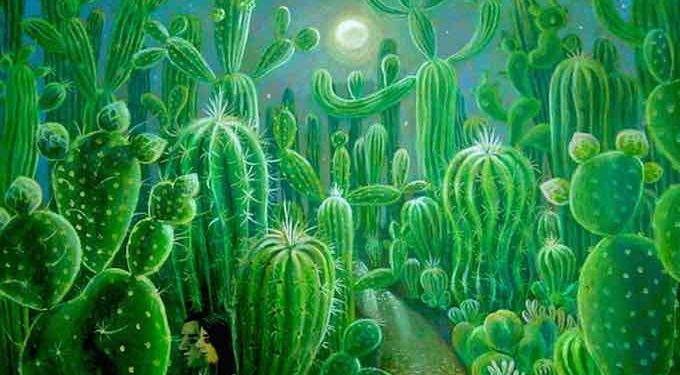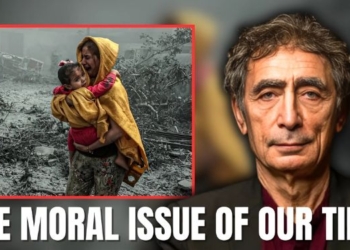
Sergey Baranov, Contributor
Waking Times
Historical accounts from 16th century show inhuman cruelty practices towards the native population of South America. Even just reading through history feels like self-imposed torture. But knowing the truth is required in order to have an objective understanding of what really happened during the conquests, when one culture assumes a divine right to oppress another.
During the Spanish conquest of Peru, the indigenous population went through hell to survive and maintain their traditions. The brutality and intolerance of the conquistadors, approved by the “papal bull” doctrine, knew no boundary and no mercy. I’ll give an example of what actually happened when boats of bandits arrived from Spain to discover the “New World.”
Columbus noted that the Taino Indians of the Dominican Republic were as happy as human beings can be, open to strangers, and eager to show their way of life and share it. Then his people burned the Indians alive in their huts. Being long separated from their own spiritual roots that go back to the Celtic and Druidic cultures of Europe, which were suppressed and eradicated by Christianity, they lost their humanity. The Spanish conquerors responded to the natives’ hospitality with inhuman cruelty. We learn it from the writing of Bartholomew de la Casas, who in 1609 recorded the crimes of the Spaniards: “They made gallows just high enough for the feet to nearly touch the ground, and by thirteens, in honor of our Redeemer and the Twelve Apostles, they put wood underneath, and with fire, they burned the Indians alive.’’
We learn about this and other inhuman cruelties from a book called A Short Account of The Destruction of the Indies, written by Bartolomé de Las Casas. A missionary that was driven by a deeply-rooted sense of justice and human principles, felt morally bound to record the crimes which have being carried out in the name of God. He recounts a story when a Taino chief Hatuey was tied to the stake but before the fire was lit, Hatuey was offered a spiritual reprieve by a Spanish priest by embracing Christianity. Hatuey responded with a question: ‘Are there people like you in heaven?’ he asked. When the priest reassured him that there were, Hatuey responded that he would prefer to go to hell, where he would not know such cruel men.
Access your inner guide with this free Shamanic Journeying seminar with Sandra Ingerman
This unimaginable horror gets even harder to grasp when put into a historical context. The Nazis, for all the atrocities they committed, burned the corpses only after they had gassed people to death. This story alone puts a big question mark on the legitimacy of an organized religion and its alleged connection to a divine mind. But this is only one of countless genocidal stories in the bloody history of the conquest, which is full of cruelty and torture.
All this can be found in the 15th century documents known as the “Papal Bulls” that provided the legal and moral ground for conquest of the New World. The “bulls” were bills of law that sanctioned genocide. The originals of these rather revealing documents can be found in the archives of Spain and Portugal. The so-called ‘’barbarous nations’’ which were discovered by the conquistadors were victims of subjugation, slavery, rape and murder, all legitimized by the rational of the Catholic Church, and all in the name of an all loving God.
What an absurd thing to suggest that the native dwellers of the land did not have the right to their land, their possessions and even to their lives simply because they weren’t Christians! Thus, the doctrine of discovery was a pretext to justify the thievery and genocide of the indigenous people. How could such a crime against humanity be done in the name of God whose only son was sacrificed for the love of humanity?
The ancient cultures of Peru situated along the costal line all the way from Arikipa, to Piura and in the mountains, have all revolved around the ceremonial use of the Huachuma cactus. Abundant archeological evidence speaks for itself. The most ancient of all Huachuma revering civilizations were the Chavin. They had built a temple in the mountains of Ancash. Chavin de Huantar is equivalent to the oracle temple in Delhi. The ancient Greeks, likely had their own mysterious rituals involving psychoactive plants. It is unclear how this tradition survived in Peru. “San Pedro” is the post-colonial name given to the psychoactive Andean cactus known under different names. ‘Huachuma’ is the old Qechua name for it, and it means ‘vision’ or ‘that which makes one drunk.’
With the invasion of the Spaniards in the early 16th century, the native shamanic traditions of Peru faced the very real threat of extinction. The brutal intolerance of the Catholic Church would only allow for obedience and conversion, and certainly not ‘paganism’ and ‘devil-worshipping’ practices, as they generally viewed any non-Catholic sanctioned practices.
Fortunately for the world, the indigenous traditions have survived until today, albeit of course in the form of syncretic religion. And although the cloak of Christian terminology was pulled over the lungs of this tradition, it hasn’t been suffocated, and remains breathing, just as the mountains and trees around you breathe when you see them through the eyes of sacred Huachuma medicine.
The resilience of the shamanic traditions is a testament to their validity, usefulness and power. Many cultures which were much more recent such as the ancient Greek culture have vanished in spite of their wide-spread influence. The lesson we learn from the survival of the ancient shamanic tradition is that there is something fundamentally human about the urge to connect with the Earth, the elements and cosmic consciousness. The need for this spiritual connection is surging from the very depths of our psyche. Just as our bodies have needs and impulses, so does the soul. Suppressing our impulses–physical or spiritual–leads to misery and alienation. And on the contrary, embracing them leads to happiness and wellbeing.
Shamanic practice has not only transformed my life but also the lives of many people who came to work with us and stay in Huachuma Wasi in Peru. The healing power of the sacred Huachuma cactus cannot be even fully described without using words like miracles and magic. It seems as though an extraordinary experience require an extraordinary words. All this is going far beyond psychology and treatment. Psychology is where this all begins, but rather quickly one realizing its limitation. Psychology is a study of the mind which in itself is the product of the soul. And soul is an uncharted territory, which many claim does not exist. But in reality, it is no different from the other side of the moon, which still exist even when not seen. This soul exploration was considered the most important journey one can take since the ancient times. Sages like Socrates, Plato, Herodotus and other in Greece, along with Confucius Lao Tzu and others in China, has dedicated their lives to the study of the soul. Some call it wisdom, other mysticism.
But regardless of the name calling, the passion to understand oneself was a tread seeing thru millennia all over the world. Know thyself was carved into the Tempe of Apollo. Why? Was it truly the quintessential message to be recorded on the stone of history? Because they knew that the key to wisdom are hidden inside of us. And if wisdom kills confusion and lead to happiness, then looking inside for this treasure is clearly the most important and meaningful thing we can do in our lives. There are many ways and many paths one can follow. Looking through enough of them myself, I found plant-based shamanism to be the fastest and most effective. In it, I found sacred Huachuma to work the best for me. Perhaps it can work for you as well, if you are able to see through stereotypes and cultural misconceptions about the subject. Consider this as a personal invitation to discover this for yourself by visiting us in Peru, where shamanic practice is legal and is a part of culture.
Our appreciation as Westerners, and an understanding of the value of the indigenous shamanic tradition provide healing for them and their cultural trauma while in exchange gives us an opportunity to heal our own connection with ourselves and Nature, absence of which lays at the very root of our mental problems.
Our documentary (below) was a spontaneous project. We filmed during the ceremonies as they were occurring. The film shows the awakening beauty of the Peruvian Andes, which we use in our healing work. If you feel compelled by its message and called to have an experience, let us here from you.
https://www.youtube.com/watch?v=I9e027bi76c
About the Author
Sergey Baranov is the author of Path, a book that will be of interest to any spiritual seeker who seeks honesty above all else. Living in various countries and growing up in different cultures, Sergey gained an understanding of the essential, a core commonality of human experience that lies beneath the differences to be found in every culture. By walking different paths and seeing through their limitations, Sergey found shamanism as a unifying path for all people regardless of their cultural background. He currently lives in Peru with his family where he conduct monthly San Pedro retreats.
Please contact Sergey at www.shamansworld.org.
You can find out more in his book Path, available on Amazon, or follow Sergey on Facebook at Facebook.com/HuachumaWasi
This article (Sacred Medicine – The Path to Unity) was originally created and published by Waking Times and is published here under a Creative Commons license with attribution to Sergey Baranov.















![Everything You Ever Wanted to Know About 9/11 Conspiracy Theory in Under 5 Minutes [VIDEO] | by James Corbett](https://consciouslifenews.com/wp-content/uploads/2018/09/911-a-conspiracy-theory-120x86.jpg)
